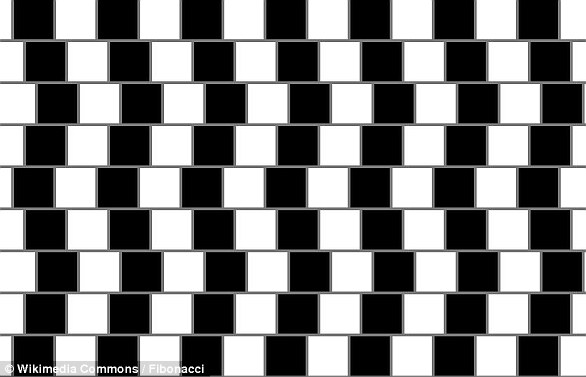
Spot the Moustached Man and the Hidden Figure in This Mind-Bending Illusion
The Café Wall Illusion: A Mind-Bending Trick of Perception
Discovered in 1979 by neuropsychologist Richard Gregory, the café wall illusion reveals how simple patterns can deceive the human eye. While observing a café near the University of Bristol, Gregory’s team noticed that the alternating black and white tiles on its walls—offset vertically and separated by gray mortar lines—created a striking visual effect. The horizontal rows appeared to slant or bulge, even though they were perfectly straight. This phenomenon, now known as the café wall illusion, has since become a cornerstone for studying how the brain processes visual information.
How It Works
The illusion relies on three key elements: alternating light and dark tiles, vertical offsets between columns, and visible gray mortar lines. When these components align, the brain perceives diagonal lines where none exist. Neurons responsible for detecting light and dark contrasts interact along the mortar lines, creating tiny brightness asymmetries. Dark tiles make adjacent mortar areas appear lighter, while light tiles darken them. These shifts form small, wedge-shaped distortions, which the brain combines into long, sloping lines (see Fig. 1).
[Image 1: Offset black and white tiles with gray mortar, creating the illusion of slanted rows. Caption: The café wall illusion’s key components: contrasting tiles, vertical offsets, and mortar lines.]
Gregory’s groundbreaking research, published in the journal Perception, revealed that the illusion operates at the retinal level before the brain interprets the image. This discovery highlighted how our visual system prioritizes contrast and edge detection over literal accuracy, often “filling in” gaps with perceived patterns.
Legacy and Applications
Beyond psychology, the café wall illusion has inspired creativity in art, architecture, and design. Graphic designers use its principles to create dynamic, eye-catching patterns, while architects play with tiling to manipulate spatial perception. A notable example is Melbourne’s Port 1010 building, which features a façade mimicking the café wall effect (Fig. 2).
[Image 2: A building with tiling resembling the café wall illusion. Caption: Architectural use of the illusion in Melbourne’s Port 1010.]
The phenomenon is also known by other names. In 1897, psychologist Hugo Munsterberg described it as the “shifted chequerboard” illusion. Additionally, its resemblance to mismatched woven patterns earned it the nickname “kindergarten illusion.”
Why It Matters
Studying illusions like this helps scientists understand vision’s complexities. The café wall effect underscores how contextual contrasts and neural processing shape reality, reminding us that perception is an active—and fallible—interpretation of sensory data.
[Image 3: Diagram of neuronal interactions causing the illusion. Caption: Neural mechanisms behind the café wall effect.]
In essence, this humble café wall continues to challenge our understanding of sight, proving that even everyday patterns can unlock profound truths about the human mind.


